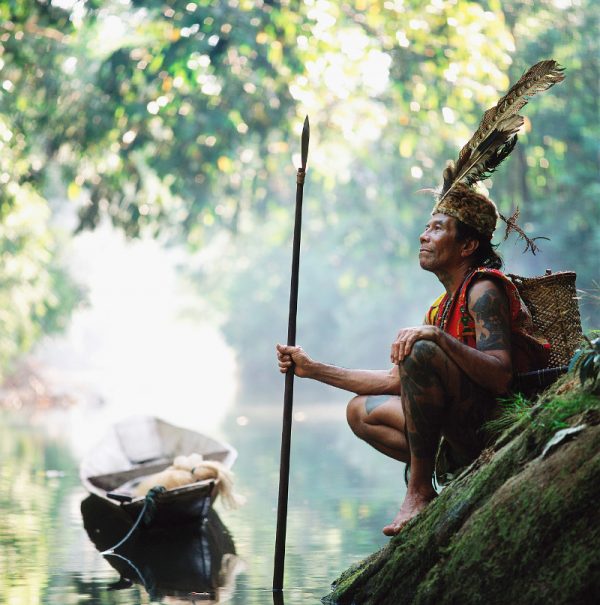
Tattoos have been an integral part of Sarawakian tribal culture for centuries. Yet in the face of rapid development and the migration of rural communities to the cities and further afield, this ancient art and knowledge of its origins and significance were almost lost.
However, efforts are underway to preserve this important cultural practice that turns a blank canvas into a journey through life. Because, like the tattoos of tribes all over the world, Sarawakian tribal tattoos are not just a form of skin decoration but a symbol of a person’s identity and a reflection of their position in society.
They usually reflect the stages and experiences the wearer has been through in their lives. For the Sarawakian tribes, they are also seen as gifts from their gods. Whatever the purpose or reason for the tattoo, each motif and its placement have great symbolic value, influenced by the wearer’s tribal heritage.
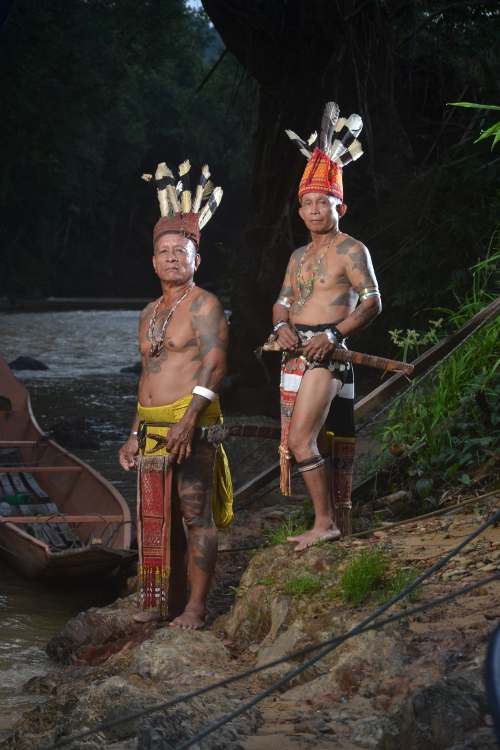
Source: Travel360
In the mid-20th century, missionaries arrived in numbers in Sarawak and spread their Abrahamic beliefs to the indigenous communities. Abrahamic religions forbade skin modification of any kind and slowly, the practise of tribal tattooing began to fade out. It wasn’t long before having tribal tattoos was seen as something primitive and the mark of a savage.
However, over the last 15 years, there has been a resurgence of this ancient practice. More and more younger members of Borneo’s indigenous tribes are voluntarily getting tattoos in an attempt to revive their ancestral traditions. This mirrors a global growth in the popularity of tattoos and it’s estimated that today, nearly half of millennials in the UK and the USA have at least one tattoo.
As a result of this wave, journalists from all over the world have visited Sarawak asking about the traditional application which helped start a conversation about tribal tattoos.

Photo courtesy of Ernesto Kalum
Ernesto Kalum is a tattoo artist from Borneo Headhunters Tattoo and Piercing Studio. He is at the forefront of efforts to create a compilation of ancient Sarawakian tattoo motifs and techniques.
Ernesto is one of the few Sarawak tattoo artists that still practices the traditional Iban hand-tapping tattooing technique. Born and bred a proud Iban, Ernesto travelled throughout the state of Sarawak, visiting some of the remotest Iban longhouses to understand the meaning behind different motifs while learning hand-tap tattooing techniques.
The hand-tapping technique
According to Ernesto, the traditional hand-tapping tattooing technique is essentially the same across all the tribes of Sarawak and there are three people involved in the whole process. One person does the tapping, the second stretches the area of the skin that is being tattooed, while the third person is the one being tattooed.

An image of Ernesto hand tapping a tattoo. Photo courtesy of Ernesto Kalum
Two sticks are used, one as a hammer and the other as a mallet. In the old days, the ink would be made from soot gathered from underneath a cooking pot and mixed with sugar cane juice. The mixture would be boiled and left to ferment for a few days before application. Today, for health and consistency reasons, commercial ink has replaced the traditional ink, but the hand-tapping technique hasn’t changed.
While all Sarawakian tribes practised the same hand-tapping technique, each tribe had different motifs and meanings behind their flora and fauna-inspired tattoos. The list below explores some of these designs.
1. Iban Tribe
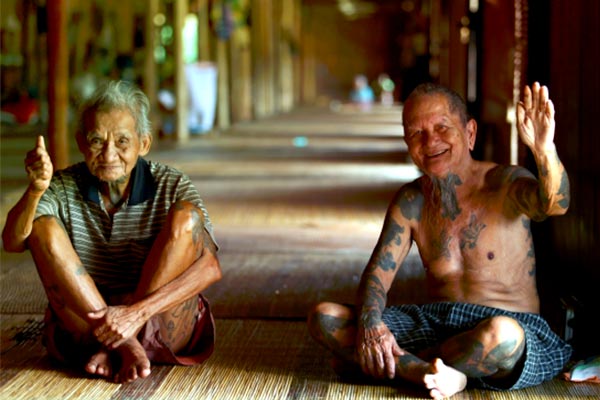
The Iban are Sarawak’s largest ethnic group. Every stroke, line, and image on their tattoo-veiled bodies has its own symbolic meaning and is a language of its very own, understood by a select few. The Ibans believe that tattoos have mystical powers that can protect an ‘iban’, which means ‘person’. They are charms given by antu (spirits) through dreams when an iban is asleep.
Young men would be tattooed as a symbol of coming-of-age. They would get the bungai terung (eggplant flower) tattoo on their shoulders before they left their village for bejalai, which means to go wander in search of knowledge and wealth. The bungai terung is said to protect and guide the men on their bejalai.
The inside of the bungai terung tattoo has a spiral pattern which is called Tali Seput Nyawa. It directly translates to ‘the rope of the breath life’. It is inspired by the intestine of a tadpole which symbolizes a person’s life line.
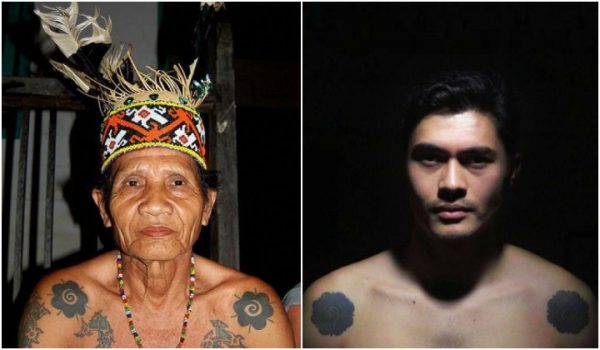
An image of the bungai terung tattoo on an Iban man. Even Hollywood star Henry Golding has these on his shoulders. Source: The Rakyat Post
As they progress through the journey of life, the Iban men would get more tattoos to mark the different experiences they have had. Their body becomes a journal and the tattoos are its journal entries. Some say that the spirits also play a role in telling the Ibans which tattoo to get and where it should be placed.
No Iban man would be caught dead without his tattoos back in the day. They believed that the tattoos were what made the Ibans visible to their gods from the heavens. If an Iban man didn’t have a tattoo, he would be shunned by the community and considered ‘telanjai’ or naked, which means that he hadn’t achieved much in life.
Ernesto told us that according to Iban folklore, in the afterlife, an iban’s spirit is believed to travel towards sebayan which is the Iban version of Olympus. His tattoos are said to be his passport to enter the gates and if he has no tattoos, the antu gerasi (spirit giant) that guards the gates would shake the bridge to sebayan until the iban falls into the river of blood and his soul drifts for eternity.
Iban women would also get tattoos to mark the different skills they have acquired through their life. No man would even consider marrying a woman without tattoos. One of the most prominent tattoos women would get is called the Pala Tumpa, which means ‘head of bracelets’. This tattoo would be given to the weavers of the sacred Iban blanket called the pua kumbu.
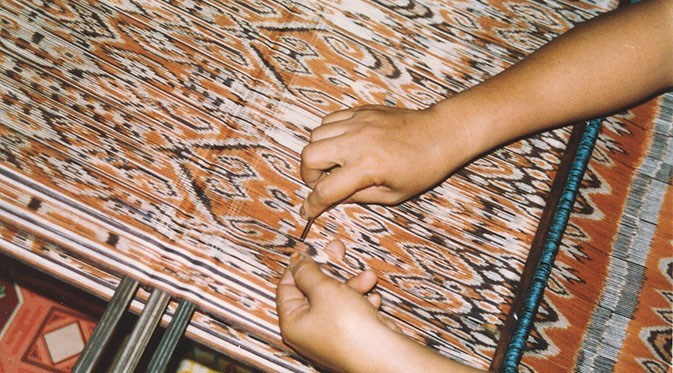
An image of the Pua Kumbu blanket. Source: ecofashionweekindonesia
The pua kumbu would be used for many significant ceremonial rituals such as receiving freshly severed human heads of captured enemies by Iban warriors.
The process of weaving the pua kumbu was considered a very dangerous job. This is because the red dye used in the weave resembled blood which put the weavers in very close contact with the spirit world, especially bad spirits.
The pala tumpa tattoos were shaped like centipedes or scorpions as these designs were believed to repel evil spirits. This is why the weaving of pua blankets was a hazardous spiritual undertaking and was considered as important as the headhunting rites practised by warriors.

The Pala Tumpa on an Iban woman. Source: Lars Krutak
2. The Kayan Tribe
The Kayan tribe also has a reputation for being fierce and appreciating tattoos. This rather small tribe was less warrior-like and had a reputation for their outstanding craftsmanship with a great eye for beauty.
According to American tattoo anthropologist Lars Krutak, in the Kayan tribe, it was mostly women who got the tattoos, which they called ‘tedek’. The tattoos would be hand-tapped in various patterns. Girls as young as ten years old would be tattooed and it would be a big, ceremonial affair that involved the whole community.
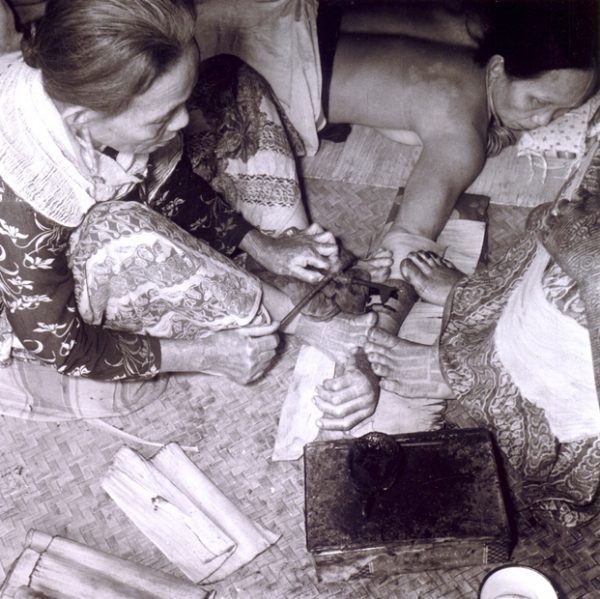
One of the last Kayan tattooists working in 1951. Source: Lars Krutak
The tattooing process would begin with the fingers and the upper part of a girl’s feet. Within a year of beginning the process, her upper arms should have been completed. The tattooing would then move on to the thighs. These tattoos had to be completed in order for the girl to be eligible for marriage.
The motif in the picture below is called song irang (shoots of bamboo) and expresses a connection between plant life and fertility. At the same time, the anthropomorphic designs above her wrists represent protective ancestor spirits. The tattoos were believed to be torches that guided people in the afterlife.
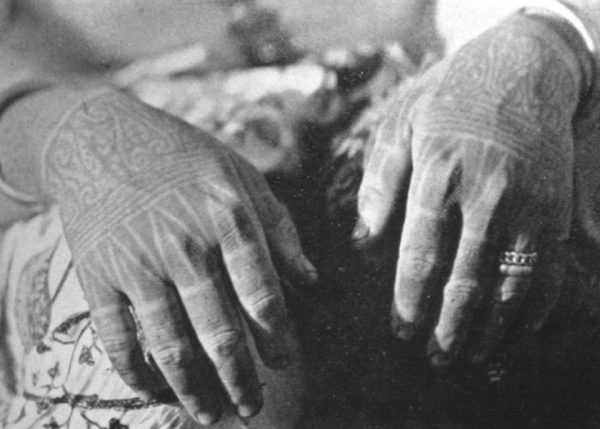
Hand tattoos on a Kayan woman. Source: Lars Krutak
In the Kayan tribe, only women were allowed to be tattoo artists as they were the only ones who could understand the significance and intricacy of the designs. Some men got tattoos too but mostly for ornamental reasons and had no sacramental significance.
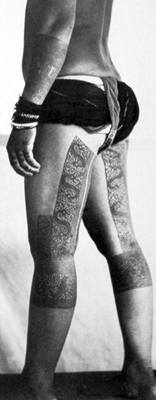
Snake-like aso’ (dragon-dog) tattoos slither down this Kayan woman’s legs, ca. 1925. They combined with other tattoo forms to repel evil and to induce fertility. Source: Lars Krutak
They were also not allowed to tattoo during rice-seeding time or if a dead person was lying unburied in the longhouse. It was considered disrespectful to let blood flow during these occasions.
Tattooists could not tattoo anyone if she had a bad dream the night before because it was considered an omen. The fear of being possessed by evil spirits also prohibited the tattooists from eating certain raw and bloody meat or fish.
If an artist ignored any of these rules, legend has it that their tattoos would not appear clearly in the afterlife while the tattoo artist herself would fall sick and die. Tattoo artists were also believed to be protected from disease-bearing spirits unleashed by Bua Kalung, the custodial spirit of tattoo artists.
3. Kenyah Tribe
The Kenyah tribe has a lot of similarities with the Kayan. Their motifs are similar and also inspired by nature and animals. The most famous motif is called Mata Aso, where ‘mata’ means eye and ‘aso’ means dog.

Image of the Mata Aso design. Source: Lars Krutak
As the name suggests, the motif was inspired by dogs. Although dogs were never sacred, they are a familiar sight in Kenyah communities and have a special place in the community. To the Kenyah, dogs were to be fed but never beaten, killed or chased away from the longhouse. Dogs could come and go as they pleased.
Incidentally, you can even see this design on their sape (musical instruments) and woven into beaded designs into their clothes.
Tattoos on Kenyah men symbolise their expeditions, achievements and even their social status within the community, just like the Ibans. The higher your status in the tribe, the more tattoos you receive and the more respect you get from tribe members.
4. Sihan and Lahanan
The Sihan are a small tribe of no more than 150 members who live in one longhouse with different entrances for each family. Their settlement is located two hours inland from the Rejang River.
Their traditions, language and practices are very similar to the Kayan, but they only abandoned their tattooing practices about 40 years ago as compared to the Kayans, who abandoned the practise around 60 years ago. Like the Kayans, only the female Sihans were allowed to be tattoo artists. These women were so revered that they were buried together with their equipment.
Magui Muling, one of the few remaining Sihan headmen, said almost ten years ago, “The only legacy we have now is our language. Apart from that, we no longer have any traditions or culture because we have assimilated into the other Orang Ulu groups such as the Kayans, Kenyahs, Ibans and even the Penans in terms of traditional costumes, music and dances, handicrafts and even arts (tattoos),”
The Borneo Post
December 23, 2012

The arm tattoos of a Sihan woman. Source: Lars Krutak
Pictured above is an example of traditional tattoos on a Sihan woman. The forearms have a tingang (hornbill) and kalong kelunan (see above) motifs.
Kalong kelunan is the human figure in a squatting position seen between the S-fret designs. It has various forms and usually is reinforced by a hornbill motif (as seen in the image above). Sometimes it is replaced by aso’ or the dragon-dog design.
The wrist tattoos represent shoots of bamboo which are considered fertility symbols.
Lars Krutak explains, “Aristocratic (Sihan) women wore the kalong, because it was believed that they were closer to the spirit world than laypersons and only they could resist any negative magic associated with the design. In the distant past, the motif may have represented a ritual offering, depicting a slave sacrifice, or a guardian spirit.”
The Lahanans, another Orang Ulu ethnic group, had similar tattooing practice. The tattooing profession was hereditary and also passed down a female line just like the Kayans, Kenyahs and Sihans. It was also a symbol of status for the men.
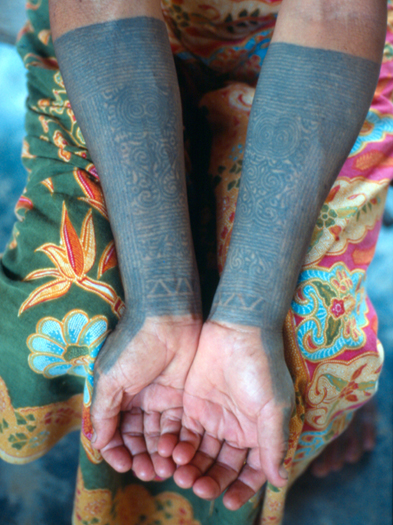
Lahanan woman with full complement of protective, traditional arm tattoos. Many motifs, reminiscent of tendrils and hooks, symbolize floral imagery and fertility. To the Orang Ulu, plants are regarded as major living things, sharing the same fundamental properties of life and death as humans. The hornbill (tingang) and kalong kelunan tattoos appear on her forearm. Both designs are protective in nature, repelling evil spirits. Double moon motifs also comprise this intricate tattoo. Source: Lars Krutak
Helping to preserve the tattoos of the Sarawakian tribes is the current interest in tattoos. Today, tribal tattoos have become a badge of modernity for a lot of millennials.
Many ancient Sarawakian designs and traditional methods have been lost, possibly forever. However, the renewed interest of the younger generations in the traditional tattooing of Sarawak is helping to preserve cultures of the many tribes struggling to adapt to the modern, fast-paced world in which we live.
The best way to experience this rich history firsthand and help carry the culture forward would be to get a traditionally hand-tapped tattoo yourself! If you’re interested in getting one while you are in Sarawak, be sure to make an appointment at Borneo Headhunters Tattoo and Piercing Studio or Skrang Tattoo Studio!
Click on the video below to check out what the hand-tap tattooing process looks like!
Borneo's Traditional Hand-tapped Tattoo - Sarawak Travel Vlog E1